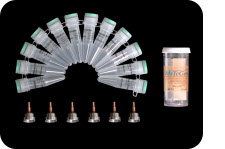Your Basket/Online Quote
Items: 1 (135,70 €)
» Search & Order
» Sign in / Register
Your Basket/Online Quote
Items: 1 (135,70 €)
» Search & Order
» Sign in / Register
Dehydration has been used as a tool for inducing structural changes in protein crystals since the earliest days of protein crystallography. Though neglected, dehydration remains a powerful tool for improving or at least modifying the diffraction properties of protein crystals.

Dehydration Salts and the Crystal Dehydration and Salvage Kit have been designed for an easy, controlled and reliable way to dehydrate protein crystals and thus provide an efficient tool for altering / improving their diffraction properties.
The Dehydration Salts contain 12 saturated salt solutions, 1 ml each, producing relative humidities in the range of 22.5 to 97.3 %.
The Crystal Dehydration and Salvage Kit, shown on the left, is composed of the 12 dehydration salts, MiTeGen's goniometer bases and RT Tubing.
The Crystal Dehydration and Salvage Kit (CO-122) is nonsaleable to USA and Japan! Please contact MiTeGen for distributor information.